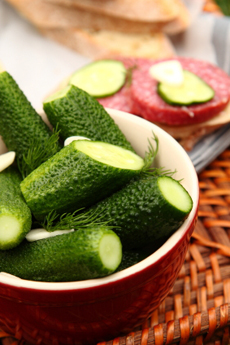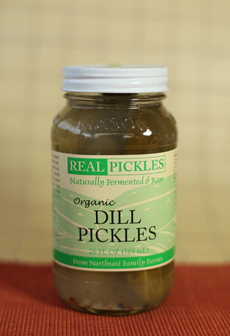

Better than a bread basket: A bowl of pickles helps you fill up with low-calorie option. Photo by Iryna Melnyk | IST.
|
STEPHANIE ZONIE is a contributing editor at THE NIBBLE.
|
|
November 2013
|
 |
Pickle Health Benefits
Page 6: Are Pickles Really Good For You?
This is Page 6 of a seven-page article on pickles, plus six pages of reviews of artisan pickle brands. On this page: pickle health benefits. Click on the black links below to visit other pages of this article.
One of my friends, upon hearing that I’d be taste-testing pickles, laughed and noted that I was finally writing an article on something healthy. I do not agree. While pickles are often considered a fun food for social gatherings and good times (it’s hard to imagine a summer cookout without pickles, and they’ve seen many a sports fan through game day), they are not nutrient-dense. If you want a healthy snack, have an apple or some broccoli.
Pickle Nutrition
Avoid pickles with sweetener, and you’ll have a low calorie snack. A medium-size pickle has 12 calories, .12 g fat, 2.68g carbs and .4g protein.
Surprisingly, cucumbers themselves offer low calories as their greatest benefit. You can fill up on several cups of them without caloric damage.
But they have insignificant vitamins, minerals or fiber.
Probiotic (Fermented) Pickles: The Scoop
The exception to this may be fermented pickles, which contain probiotics and live enzymes. Here’s more information on fermented pickles. The biggest issues I have with probiotic claims are that I’m not a huge believer in the power of ingesting live enzymes (they get destroyed during the digestion process anyway) and the lack of specifics regarding probiotics.
- Probiotics must be present in extremely high concentrations to be effective.
- Even supposing one might not get all of the probiotics in one’s gut through ingesting pickles, to date, no one, not even those who make fermented pickles, has been able to quote me any figures on approximate numbers for probiotics in a serving of fermented pickles. It may be that there is too much variation between batches for accurate figures to be known.
- And while probiotics are not simply a numbers game, if you’re going to ask me to believe that they’re present in sufficient quantities for a fermented vegetable to be healthy, you’re going to have to give me some ballpark figures.
|
|

Fermented brands like Real Pickles contain probiotics and live enzymes. Photo courtesy Real Pickles. |
- Rejuvenative Foods has a product called Vegi Delite, which consists of fermented cabbage, carrots, and beets along with lemon, garlic and dill. According to a company representative, Vegi Delite has been tested for probiotics and contains 5.5 million lactobacillus per gram. Their fermented pickles, however, have not been tested.
What about the assertion that fermented vegetables have many times the vitamin content of the same vegetable when it is not fermented?
I have seen what I consider reliable information about this occurrence in cabbage, but not for cucumbers. The World’s Healthiest Foods website has an excellent article about the subject.
What is true is that fermentation renders foods easier to digest.
Fermentation begins the process of breaking down foods, much the way the human system does during the digestion process. Michael Pollan says that fermentation “breaks long chains of proteins, fats, and carbohydrates our bodies might not be able to make good use of into simpler, safer compounds that they can.” Pollan also avers that fermenting foods intensifies their flavors, which some people will enjoy and others will not.
Having said all of that, pickles, even those that are not fermented, have some advantages as a snack food.
- Most are low in calories, with little or no fat, so even if you eat more than one serving at a time pickles are unlikely to pack on the pounds.
- Pickles and pickle brine can add flavor and zest to everything from egg salad to grilled veggie burgers to boiled potatoes, eliminating the need to add cholesterol or other fat.
- Many pickles are low in carbohydrates, although those with added sweeteners are less so. Sodium levels are a concern for those who must watch their intake of this mineral, but there are lower-sodium brands.
What should you take away from this? For most healthy individuals, eating pickles in moderation just because you enjoy them is not going to pose a problem. And if you are consuming them simply because you like them, it shouldn’t matter whether you have fermented pickles, refrigerator pickles, or fresh-packed pickles. Try different pickles and see what you like.
A word about portion sizes here:
- Serving Size. While some pickle makers tell you that a serving size is “about 6 chips” or “about ¾ of a spear” (who on earth is going to eat just ¾ of a pickle spear?), others simply state that a serving is 1 ounce (28 grams) or another, seemingly random figure (such as 60 grams or 1.3 ounces), which is unhelpful at best and infuriating at worst. Are people expected to keep a scale handy when opening a jar of pickles?
- Sodium. Especially if you need to watch your sodium intake, it would be very helpful indeed for consumers to understand how many chips/spears/slices/chunks constitute one serving of any given brand/type of pickles. Further, with the realization that portion sizes in the U.S. can be unreasonably large, some listed serving sizes are absurdly tiny. In the course of evaluating pickles for this article, I’ve seen serving sizes of 10 ml (about two teaspoons), one tablespoon, 15 grams (a little more than one-half ounce), and even eight grams (a bit more than one-quarter of an ounce). This is as bad as the frozen pizza manufacturers who list a serving as one-third or one-quarter of a pizza, when a child of twelve could easily consume more than that. Why the miniscule serving sizes? So manufacturers can list equally small figures for calorie count, sodium content, grams of sugar per serving, and the like.
Many Americans need to learn to reduce the sizes of portions they eat, but wouldn’t it be nice for pickle manufacturers to also list realistic portion sizes?
Drinking Pickle Brine
Pickle brine (sometimes called pickle juice) can be very refreshing on a hot day, and there are legions of fans of pickle pops, which consist simply of frozen brine. Some people add pickle juice to their martinis for a Pickletini or use it as a chaser for whisky (the latter is called a Pickleback or a Pickleback Shot).
And how about those athletes who drink pickle juice as a way to restore electrolytes after a workout, or as a means of preventing leg cramps?
2009 Study
In 2009, The Journal of Athletic Training published a study (done on a very small number of subjects) measuring electrolyte and plasma changes in subjects who drank small volumes (about 3 ounces) of pickle juice, water, or a common carbohydrate-electrolyte beverage (for the latter, read “sports drink”). The subjects were in a normal state of body water content and rested.
The results of the study showed that neither pickle juice nor a sports drink caused changes in plasma electrolytes or plasma volume. If leg cramps are indeed cause by electrolyte loss due to heavy sweating during exercise, as some trainers believe, drinking a shot of pickle juice or sports drinks is unlikely to help. (In the study, water ingestion slightly decreased plasma potassium concentration at the 60 minute mark.)
2011 Study
A more recent article published at BestFoodFacts.org agrees, citing the opinion of Dr. Liz Applegate, Director of Sports Nutrition at the University of California-Davis. Dr. Applegate states that the evidence for pickle juice combating cramps is anecdotal.
But some athletes, trainers, and coaches continue to swear by pickle brine. In 2011, ThePostGame.com ran an article about the merits of pickle juice in stopping leg cramps among professional football players. There’s even a pickle juice-based sports drink, Golden Pickle Juice.
Perhaps strangest of all are the claims that pickle juice can cure a hangover or stop PMS cramps. There is no scientific evidence for either, however.
Continue To Page 7: Best Pickle Brand Reviews
Go To The Article Index Above
Sources
Acknowledgements
- FDP, Pickle “Gofer” Extraordinaire (PA and NJ)
- Mark Ritter, Pickle “Gofer” Extraordinaire (Texas)
- All of the pickle manufacturers who talked to me about pickles in general,
their pickles in particular, and/or sent samples

|





